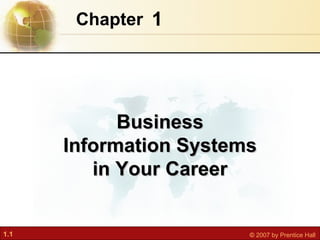
Business information systems in your career
- 1. 1 Chapter Business Information Systems in Your Career
- 6. Essentials of Business Information Systems Chapter 1 Business Information Systems in Your Career NBA Teams Make a Slam Dunk with Information Technology
- 12. Essentials of Business Information Systems Chapter 1 Business Information Systems in Your Career New products, services, and business models: The Role of Information Systems in Business Today With its stunning multitouch display, full Internet browsing, digital camera, and portable music player, Apple’s iPhone set a new standard for mobile phones. Other Apple products have transformed the music and entertainment industries.
- 15. Essentials of Business Information Systems Chapter 1 Business Information Systems in Your Career The Role of Information Systems in Business Today Information Builders’ digital dashboard delivers comprehensive and accurate information for decision making. The graphical overview of key performance indicators helps managers quickly spot areas that need attention.
- 17. Essentials of Business Information Systems Chapter 1 Business Information Systems in Your Career The Role of Information Systems in Business Today In a Toyota factory, the assembly line produces a superior product in less time, using less inventory, and having fewer defects than the competition. Toyota uses information systems to monitor inventory levels and manage production scheduling.
- 20. It Isn’t Simply Technology: The Role of People and Organizations Data and Information Essentials of Business Information Systems Chapter 1 Business Information Systems in Your Career Figure 1-1 Raw data from a supermarket checkout counter can be processed and organized to produce meaningful information, such as the total unit sales of dish detergent or the total sales revenue from dish detergent for a specific store or sales territory.
- 22. It Isn’t Simply Technology: The Role of People and Organizations Functions of an Information System Essentials of Business Information Systems Chapter 1 Business Information Systems in Your Career Figure 1-2 An information system contains information about an organization and its surrounding environment. Three basic activities—input, processing, and output— produce the information organizations need. Feedback is output returned to appropriate people or activities in the organization to evaluate and refine the input. Environmental actors, such as customers, suppliers, competitors, stockholders, and regulatory agencies, interact with the organization and its information systems.
- 25. It Isn’t Simply Technology: The Role of People and Organizations Information Systems Are More Than Computers Essentials of Business Information Systems Chapter 1 Business Information Systems in Your Career Figure 1-3 Using information systems effectively requires an understanding of the organization, people, and information technology shaping the systems. An information system provides a solution to important business problems or challenges facing the firm.
- 29. It Isn’t Simply Technology: The Role of People and Organizations Interactive Session: Technology UPS Competes Globally with Information Technology Essentials of Business Information Systems Chapter 1 Business Information Systems in Your Career Using a handheld computer called a Delivery Information Acquisition Device (DIAD), UPS drivers automatically capture customers’ signatures along with pickup, delivery, and time card information. UPS information systems use these data to track packages while they are being transported.
- 39. Problem Solving Is a Continuous Four-Step Process Essentials of Business Information Systems Chapter 1 Business Information Systems in Your Career Figure 1-4 During implementation and thereafter, the outcome must be continually measured and the information about how well the solution is working is fed back to the problem solvers. In this way, the identification of the problem can change over time, solutions can be changed, and new choices made, all based on experience. Understanding Information Systems: A Business Problem-Solving Approach
- 47. Essentials of Business Information Systems Chapter 1 Business Information Systems in Your Career How Information Systems Will Affect Business Careers Information Systems and Your Career Equities analysts depend heavily on information systems for organizing and analyzing very large amounts of financial data.
